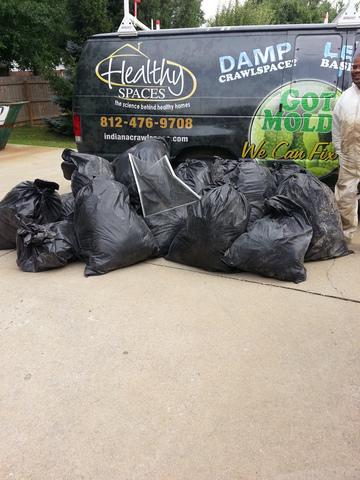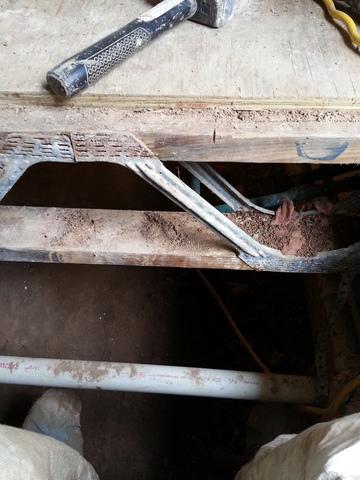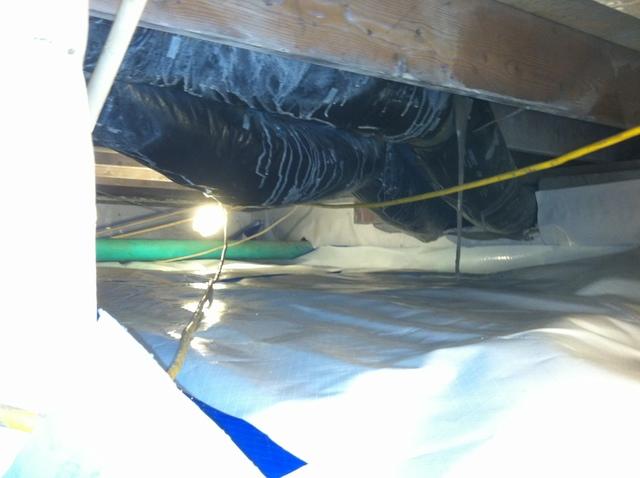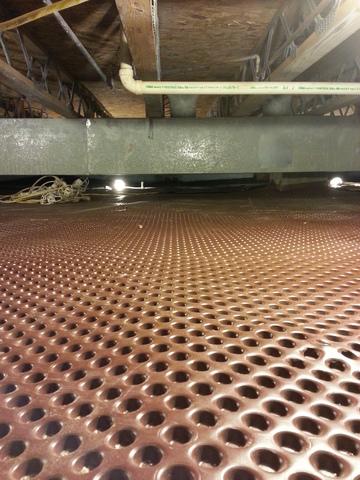
Cleaning out Moldy Dirt and Debris in Fuquay Crawlspace
Many buildings incorporate vapor barriers in the design of their walls and floors. Vapor barriers must be located and installed properly or the building may have moisture problems. A vapor barrier is a layer of material that slows or prevents the absorption or release of moisture from or into a wall or floor. Vapor barriers can prevent damp or wet building materials from drying quickly enough to prevent mold growth. Common moisture problems include: Leaking roofs. Leaking or condensing water pipes, especially pipes inside wall cavities or pipe chases. Leaking fire-protection sprinkler systems. Landscaping, gutters, and down spouts that direct water into or under a building. High humidity (> 60% relative humidity). Unvented combustion appliances such as clothes dryers vented into a garage (Clothes dryers and other combustion appliances should be vented to the outside). The best way to resolve many of those issues is to install a vapor barrier, but first, you have to clean out all the damp, rotting insulation and other accumulated dirt and debris from the space like our crawlspace experts did here.

Mold Growing in Fuquay Crawlspace
Crawl spaces where relative humidity (RH) is high are common sites of hidden mold growth, particularly if the crawl space has a bare earth floor. The soil will wick moisture, through capillary action, from moist to dry areas. The relative warmth of the crawl space will dry the soil by evaporation, adding this moisture to the air in the crawl space where it can cause mold to grow. Also, in areas where the water table is high and weather conditions are suitable, ground water may enter a crawl space. The moisture that accumulates in a crawl space may also enter another part of the building and contribute to mold growth there. Moisture can pass from a crawl space into a building through cracks in walls, floors, and ceilings

Mold Spores in Fuquay Crawlspace
Mold spores are ubiquitous; they are found both indoors and outdoors. Mold spores cannot be eliminated from indoor environments. Some mold spores will be found floating through the air and in settled dust; however, they will not grow if moisture is not present. Mold is not usually a problem indoors — unless mold spores land on a wet or damp spot and begin growing. As molds grow they digest whatever they are growing on. Unchecked mold growth can damage buildings and furnishings; molds can rot wood, damage drywall, and eventually cause structural damage to buildings. Mold can cause cosmetic damage, such as stains, to furnishings. The potential human health effects of mold are also a concern. It is important, therefore, to prevent mold from growing indoors.

Moisture Control Needed in Fuquay Crawlspace
To grow indoors, mold needs moisture and food. Moisture is the most important factor influencing mold growth indoors. Controlling indoor moisture helps limit mold growth. Moisture control is the key to mold control. Mold does not need a lot of water to grow. A little condensation, in a bathroom or around a window sill, for example, can be enough. Common sites for indoor mold growth include bathroom tile and grout, basement walls, and areas around windows, near leaky water fountains, and around sinks. Common sources of water or moisture include roof leaks, condensation due to high humidity or cold spots in a building, slow leaks in plumbing fixtures, humidification systems, sprinkler systems, and floods

Mold Growth in Fuquay Crawlspace
Besides moisture, mold needs nutrients, or food, to grow. Mold can grow on virtually any organic substance. Most buildings are full of organic materials that mold can use as food, including paper, cloth, wood, plant material, and even soil. In most cases, temperature is not an issue; some molds grow in warm areas, while others prefer cool locations such as bread stored in a refrigerator. Often, more than one type of mold can be found growing in the same area, although conditions such as moisture, light, and temperature may favor one species of mold over another.

Installing Vapor Barrier in Fuquay Crawlspace
Installing a crawl space vapor barrier is one of the most cost-effective ways to improve your home and prevent the need for future crawl space repairs. Along with protection from mold and rot, a dry crawl space will also be inhospitable to termites, cockroaches, ants, crickets, and many other pests that need excess moisture to survive. Mice and rats are deterred by the plastic vapor barrier, and flooding waters will be kept at bay.

Fuquay Crawlspace causing allergic reactions and asthma symptoms
Allergic reactions to mold are common and can be immediate or delayed. Repeated or single exposure to mold, mold spores, or mold fragments may cause non-sensitive individuals to become sensitive to mold, and repeated exposure has the potential to increase sensitivity. Allergic responses include hay fever-like symptoms such as headache, sneezing, runny nose, red eyes, and skin rash (dermatitis). Molds can cause asthma attacks in people with asthma who are allergic to mold. In addition, molds can irritate the eyes, skin, nose, throat, and lungs of individuals whether or not they are allergic to mold.

High Humidity Causing Mold Growth in Fuquay Crawlspace
Condensation can be a sign of high humidity. When warm, humid air contacts a cold surface, condensation may form. (To see this, remove a cold bottle of water from a refrigerator and take it outside on a hot day. Typically, condensation will form on the outside of the bottle.) Humidity can be measured with a humidity gauge or meter; models that can monitor both temperature and humidity are generally available for less than $50 at hardware stores or on the Internet.

Stinky Crawlspace in Fuquay
Breathing in mold may also cause hypersensitivity pneumonitis, an uncommon disease that resembles bacterial pneumonia. In addition, mold exposure may result in opportunistic infections in persons whose immune systems are weakened or suppressed. When mold grows indoors, the occupants of a building may begin to report odors and a variety of symptoms including headaches, difficulty breathing, skin irritation, allergic reactions, and aggravated asthma symptoms. These and other symptoms may be associated with exposure to mold. But all of these symptoms may be caused by other exposures or conditions unrelated to mold growth. Therefore, it is important not to assume that, whenever any of these symptoms occurs, mold is the cause. The first step to encapsulating a crawlspace is to install dimple roll. This product allows the moisture to be isolated from the crawlspace air under the vapor barrier.

Dimple Roll in a Crawlspace in Fuquay
Crawl space liners rest directly on the crawl space floor. If your crawl space is flooding, water can be trapped underneath, never making it to your perimeter drain. The raised dimples on our CleanSpace Drainage Matting gives the water flooding into your crawl space a channel underneath your crawl space liner. This directs the water flooding your crawl space to your perimeter crawl space drain and sump pump system.

Sealing Fuquay Crawlspace
By sealing a crawl space, you also keep away odors and allergenic mold spores that would otherwise rise up through the floor and into your home due to the stack effect. By sealing your crawl space, you keep the summer heat out of your home and the winter cold away from your furnace, water heater, and other utilities.

Installing Dimple Roll in Fuquay Crawlspace
Installation Time: CleanSpace Drainage Matting, or Dimple Roll, should not significantly add to the installation time of your crawl space vapor barrier system. When we send our crew to your home, one member will lay the drainage matting while another installs the liner over the top. A crawl space system usually installs in less than a day.

Final Rehabilitation of Fuquay Crawlspace
The final step in making this crawlspace a Healthy Space is to add a dehumidifier. The best way to bring the most value to an encapsulated crawl space is to include an energy efficient crawl space dehumidifier in the installation. Once the air has been dried, the process of conditioning becomes more economical, and because it reduces energy usage, a greener solution for your home. Each system is also built with a special air filter that can remove particles from the air as small as 2 microns- smaller than dust mites, pollen, most mold spores, and a variety of other indoor allergens. And with a design than is self-draining, it's able to run with minimal upkeep and maintenance. A special air filtration system is included with each system that's designed to remove particles from the air as small as 2 microns- which is smaller than many indoor allergens, including dust mite waste, pollen, and most mold spores. With a fast installation that usually lasts less than a day, you can do wonders to increase your comfort and lower your home's energy bills.
